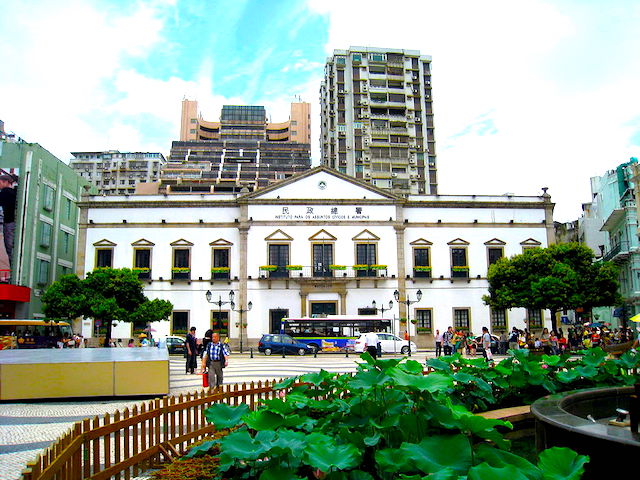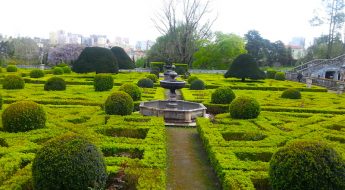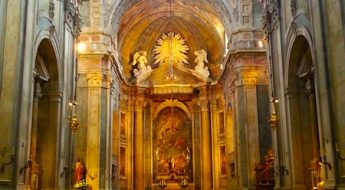
The Leal Senado building in Macau isn’t quite as iconic as the ruins of the church of São Paulo, but it comes close. The square in front of it is perhaps more famous.
 Senado Square in Macau as seen from a window on the upper floor of the Leal Senado building, 2014.
Senado Square in Macau as seen from a window on the upper floor of the Leal Senado building, 2014.
The building itself is a handsome Portuguese baroque-style edifice. Nowadays a busy thoroughfare runs directly in front of it, which you have to cross to get to the square, and vice-versa.
 The Leal Senado building in Macau. Credit: By WiNG – Own work, CC BY 3.0, https://commons.wikimedia.org/w/index.php?curid=4464094.
The Leal Senado building in Macau. Credit: By WiNG – Own work, CC BY 3.0, https://commons.wikimedia.org/w/index.php?curid=4464094.
Although the footprint of the building is still the same as it was when it was built in the 1780s, the facade has been altered, mainly due to repeated storm damage. Poor Macau regularly takes a beating from typhoons blowing in off the South China Sea.
In the rear garden there are pictures rendered in azulejos, the distinctive blue and white Portuguese tile work, that chronicle the changing face of the building. The one pictured below shows how it looked in 1789, the year that construction was completed.
 A representation in azulejos of the Leal Senado building’s appearance in 1789. Photographed in October, 2015.
A representation in azulejos of the Leal Senado building’s appearance in 1789. Photographed in October, 2015.
The appearance of the facade is considerably less austere. Note the broken pediments over the upper windows, and also the greater number of pilasters. One of the most striking differences is the roofline. The original guise of the building is considerably more Rococo than what we see today.
This next picture shows how the building looked a century later.

The Leal Senado builing in 1888. Photographed in October, 2015.
It looks almost as it does now, except for the roofline.
Helpfully, there is a third azulejo rendering that shows the facade after the most recent restoration, which took place in the year that the Portuguese formally handed Macau back to China.

The Leal Senado building after its last restoration. Photographed in October, 2015.
If you look closely, you’ll see that the name is still only in Portuguese, while today Chinese characters are included.
Now why is it called the Leal Senado? To take the second word first, the Senado (Senate) was in effect the city council. It was established soon after the city was founded in 1557. In 1640, when Portugal proclaimed its independence after 80 years under Castilian rule, the new king, John IV (r. 1640-1668), conferred the motto “There is none more loyal” on Macau, apparently for its steadfast determination to remain Portuguese in the previous decades. The complete name of the city under Portuguese rule was Cidade do Santo Nome de Deus de Macau, Não há outra mais Leal, which translates as City of the Holy Name of God of Macau, There is none more loyal. These words are emblazoned on an arch over the staircase of the building. Unfortunately, I didn’t photograph them.
According to Wikipedia, the site of the building was purchased by the Senate in 1784 for 80,000 taels of silver. There had previously been a pavilion in Chinese style in which Portuguese and Chinese officials met from time to time.
Today the Leal Senado building is home to the Institute of Civic and Municipal Affairs. It also houses an important library containing thousands of books accumulated under Portuguese rule. Space on the ground floor has also been arranged to accommodate art exhibitions. When I visited in October, 2015, calligraphy and other art by local artists was on display.
 Calligraphy and paintings by Macau artists exhibited in the Leal Senado building. Photographed in October, 2015.
Calligraphy and paintings by Macau artists exhibited in the Leal Senado building. Photographed in October, 2015.
Have you visited the Leal Senado building? Please share your impressions of it below, on the Lotus & Persimmon Facebook page, or under a relevant image in our gallery on Instagram (@lotusandpersimmon).


















Leave a Comment